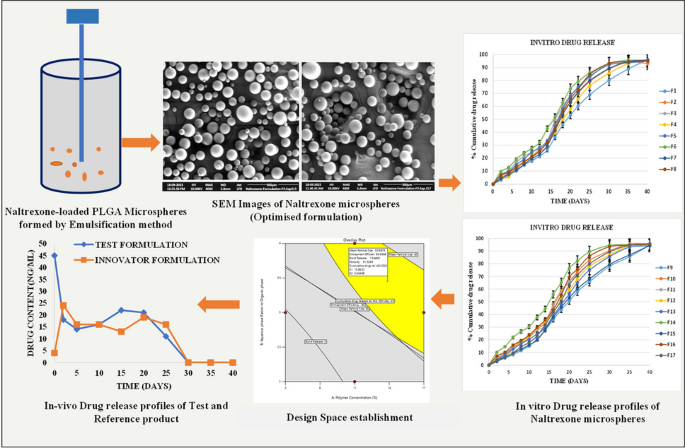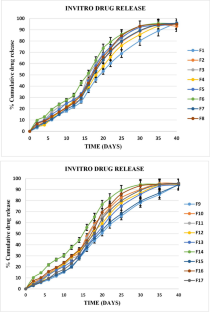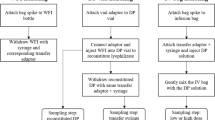Abstract
The formulation of microspheres involves a complex manufacturing process with multiple steps. Identifying the appropriate process parameters to achieve the desired quality attributes poses a significant challenge. This study aims to optimize the critical process parameters (CPPs) involved in the preparation of naltrexone microspheres using a Quality by Design (QbD) methodology. Additionally, the research aims to assess the drug release profiles of these microspheres under both in vivo and in vitro conditions. Critical process parameters (CPPs) and critical quality attributes (CQAs) were identified, and a Box-Behnken design was utilized to delineate the design space, ensuring alignment with the desired Quality Target Product Profile (QTPP). The investigated CPPs comprised polymer concentration, aqueous phase ratio to organic phase ratio, and quench volume. The microspheres were fabricated using the oil-in-water emulsion solvent extraction technique. Analysis revealed that increased polymer concentration was correlated with decreased particle size, reduced quench volume resulted in decreased burst release, and a heightened aqueous phase ratio to organic phase ratio improved drug entrapment. Upon analyzing the results, an optimal formulation was determined. In conclusion, the study conducted in vivo drug release testing on both the commercially available innovator product and the optimized test product utilizing an animal model. The integration of in vitro dissolution data with in vivo assessments presents a holistic understanding of drug release dynamics. The QbD approach-based optimization of CPPs furnishes informed guidance for the development of generic pharmaceutical formulations.
Graphical Abstract





Similar content being viewed by others
Data Availability
All data analysed during this study are included in this published article.
Abbreviations
- CPPs:
-
Critical process parameters
- QBD:
-
Quality be design
- CQA:
-
Critical Quality Attribute
- QTPP:
-
Quality Target Product Profile
- PLGA:
-
Poly Lactate co glycolate
- FDA:
-
Food and Drug Administration
- DOE:
-
Design of Experiments
- DCM:
-
Dichloromethane
- PVA:
-
Polyvinyl chloride
- BBD:
-
Boc Behnken Design
- PS:
-
Particle Size
- EE:
-
Entrapment efficiency
- BR:
-
Burst Release
- DR:
-
Drug Release
- THF:
-
Tetrahydrofuran
- LC:
-
Drug Loading Content
- DSC:
-
Differential scanning calorimetry
- SEM:
-
Surface electron microscopy
- PBS:
-
Phosphate-buffered saline
- t1/2:
-
Half-life
- MRT:
-
Mean Residence Time
References
Prajapati SK, Jain A, Jain A, Jain S. Biodegradable polymers and constructs: A novel approach in drug delivery. Eur Polym J. 2019;120:109191.
Patel M, Jha A, Patel R. Potential application of PLGA microsphere for tissue engineering. J Polym Res. 2021;28:214.
Butreddy A, Gaddam RP, Kommineni N, Dudhipala N, Voshavar C. PLGA/PLA-based long-acting injectable depot microspheres in clinical use: production and characterization overview for protein/peptide delivery. IJMS. 2021;22(16):8884.
Jain A, Kunduru KR, Basu A, Mizrahi B, Domb AJ, Khan W. Injectable formulations of poly(Lactic acid) and its copolymers in clinical use. Adv Drug Deliv Rev. 2016;107:213–27.
Jin S, Xia X, Huang J, Yuan C, Zuo Y, Li Y, et al. Recent advances in PLGA-based biomaterials for bone tissue regeneration. Acta Biomater. 2021;127:56–79.
Kohno M, Andhariya JV, Wan B, et al. The effect of PLGA molecular weight differences on risperidone release from microspheres. Int J Pharm. 2020;582:119339.
Andhariya JV, Shen J, Choi S, Wang Y, Zou Y, Burgess DJ. Development of in vitro-in vivo correlation of parenteral naltrexone loaded polymeric microspheres. JCR. 2017;255:27–35.
Hales D, Vlase L, Porav SA, et al. A quality by design (Qbd) study on enoxaparin sodium loaded polymeric microspheres for colon-specific delivery. Eur J Pharm Sci. 2017;100:249–61.
Hua Y, Su Y, Zhang H, et al. Poly(Lactic-co-glycolic acid) microsphere production based on quality by design: a review. Drug Deliv. 2021;28(1):1342–55.
Lakshmikanth Reddy P, Shanmugasundaram S. QBD approach for design and characterization of pramlintide microspheres for controlled drug release. J Pharm Innov. 2023;18:2325–47.
Haidar A, Tsoukas MA, Bernier-Twardy S, Yale J-F, Rutkowski J, Bossy A, et al. A novel dual-hormone insulin-and-pramlintide artificial pancreas for type 1 diabetes: a randomized controlled crossover trial. Diabetes Care. 2020;43:597–606.
Dhamecha D, Movsas R, Sano U, Menon JU. Applications of alginate microspheres in therapeutics delivery and cell culture: Past, present and future. Int J Pharm. 2019;569:118627.
Lengyel M, Kállai-Szabó N, Antal V, Laki AJ, Antal I. Microparticles, microspheres, and microcapsules for advanced drug delivery. Sci Pharm. 2019;87:20.
Su Y, Zhang B, Sun R, Liu W, Zhu Q, Zhang X, et al. PLGA-based biodegradable microspheres in drug delivery: recent advances in research and application. Drug Deliv. 2021;28:1397–418.
Park H, Ha E, Kim J, Kim M. Injectable sustained-release poly(Lactic-co-glycolic acid) (Plga) microspheres of exenatide prepared by supercritical fluid extraction of emulsion process based on a design of experiment approach. Bioeng Transl Med. 2023;8(3):e10485.
Gu B, Burgess DJ. Prediction of dexamethasone release from PLGA microspheres prepared with polymer blends using a design of experiment approach. Int J Pharm. 2015;495(1):393–403.
Jhawat V, Gulia M, Gupta S, Maddiboyina B, Dutt R. Integration of pharmacogenomics and theranostics with nanotechnology as quality by design (QbD) approach for formulation development of novel dosage forms for effective drug therapy. JCR. 2020;327:500–11.
Grangeia HB, Silva C, Simões SP, Reis MS. Quality by design in pharmaceutical manufacturing: A systematic review of current status, challenges and future perspectives. EJPB. 2019;147:19–37.
Shah M, Patel N, Tripathi N, Vyas VK. Capillary electrophoresis methods for impurity profiling of drugs: A review of the past decade. JPA. 2022;12:15–28.
Soni G, Kale K, Shetty S, Gupta MK, Yadav KS. Quality by design (QbD) approach in processing polymeric nanoparticles loading anticancer drugs by high pressure homogenizer. Heliyon. 2020;6:e03846.
Andhariya JV, Choi S, Wang Y, Zou Y, Burgess DJ, Shen J. Accelerated in vitro release testing method for naltrexone loaded PLGA microspheres. Int J Pharm. 2017;520(1–2):79–85. https://doi.org/10.1016/j.ijpharm.2017.01.050.
Naltrexone long acting formulation and method of use. https://patentimages.storage.googleapis.com/76/11/01/48ba9849b5c1fd/US7919499.pdf
Rapalli VK, Banerjee S, Khan S, et al. QbD-driven formulation development and evaluation of topical hydrogel containing ketoconazole loaded cubosomes. Mater Sci Eng C. 2021;119:111548.
Park H, Ha E, Kim J, Kim M. Injectable sustained-release poly(lactic-co-glycolic acid) (PLGA) microspheres of exenatide prepared by supercritical fluid extraction of emulsion process based on a design of experiment approach. Bioeng Transl Med. 2023;8:e10485.
Gu B, Burgess DJ. Prediction of dexamethasone release from PLGA microspheres prepared with polymer blends using a design of experiment approach. Int Pharm. 2015;495:393–403.
Dorati R, DeTrizio A, Genta I, et al. An experimental design approach to the preparation of pegylated polylactide-co-glicolide gentamicin loaded microparticles for local antibiotic delivery. Mater Sci Eng C. 2016;58:909–17.
Wu Z, Zhao M, Zhang W, Yang Z, Xu S, Shang Q. Influence of drying processes on the structures, morphology and in vitro release profiles of risperidone-loaded PLGA microspheres. J Microencapsul. 2019;36(1):21–31.
Ronkart SN, Paquot M, Fougnies C, Deroanne C, Van Herck JC, Blecker C. Determination of total water content in inulin using the volumetric Karl Fischer titration. Talanta. 2006;70(5):1006–10.
Han J, Fitzpatrick J, Cronin K, Maidannyk V, Miao S. Particle size, powder properties and the breakage behaviour of infant milk formula. J Food Eng. 2021;292:110367.
Caputo F, Vogel R, Savage J, Vella G, Law A, Della Camera G, et al. Measuring particle size distribution and mass concentration of nanoplastics and microplastics: addressing some analytical challenges in the sub-micron size range. J Colloid Interface Sci. 2021;588:401–17.
Varia U, Patel A, Katariya H, Detholia K. Formulation and optimization of polymeric agglomerates of Bosentan monohydrate by crystallo-co-agglomeration technique. Bull Natl Res Cent. 2022;46:156.
Fang Y, Zhang N, Li Q, Chen J, Xiong S, Pan W. Characterizing the release mechanism of donepezil-loaded PLGA microspheres in vitro and in vivo. JDDST. 2019;51:430–7.
Hsu M-Y, Huang Y-T, Weng C-J, Chen C-M, Su Y-F, Chu S-Y, et al. Preparation and in vitro/in vivo evaluation of doxorubicin-loaded poly[lactic-co-glycol acid] microspheres using electrospray method for sustained drug delivery and potential intratumoral injection. Colloids Surf. 2020;190:110937.
Hasan ML, Kim B, Padalhin AR, Faruq O, Sultana T, Lee B-T. In vitro and in vivo evaluation of bioglass microspheres incorporated brushite cement for bone regeneration. Mater Sci Eng C. 2019;103:109775.
Li H, Xu Y, Tong Y, Dan Y, Zhou T, He J, et al. Sucrose acetate isobutyrate as an in situ forming implant for sustained release of local anesthetics. CDD. 2019;16:331–40.
Vishwa B, Moin A, Gowda DV, Rizvi SMD, Hegazy WAH, Abu Lila AS, et al. Pulmonary targeting of inhalable moxifloxacin microspheres for effective management of tuberculosis. Pharmaceutics. 2021;13:79.
Pervaiz F, Ahmad M, Li L, Murtaza G. Development and characterization of olanzapine loaded poly(lactide-co-glycolide) microspheres for depot injection: in vitro and in vivo release profiles. CDD. 2019;16:375–83.
Liang B, Zhao D, Liu Y, Guo X, Zhang H, Zhang L, et al. Chemoembolization of liver cancer with doxorubicin-loaded CalliSpheres microspheres: plasma pharmacokinetics, intratumoral drug concentration, and tumor necrosis in a rabbit model. Drug Deliv and Transl Res. 2020;10:185–91.
Vugmeyster Y, Xu X, Theil F-P, Khawli LA, Leach MW. Pharmacokinetics and toxicology of therapeutic proteins: Advances and challenges. World J Biol Chem. 2012;3:73–92.
Sharifi F, Otte A, Yoon G, Park K. Continuous in-line homogenization process for scale-up production of naltrexone-loaded PLGA microparticles. JCR. 2020;325:347–58. https://doi.org/10.1016/j.jconrel.2020.06.023.
Wang Y, Burgess DJ. Influence of storage temperature and moisture on the performance of microsphere/hydrogel composites. Int J Pharm. 2013;454(1):310–5. https://doi.org/10.1016/j.ijpharm.2013.06.012.
Guideline IH. Impurities: Guideline for residual solvents Q3C (R5). Current Step. 2005;4:1–25.
Zeng W, Hui H, Liu Z, Chang Z, Wang M, He B, et al. TPP ionically cross-linked chitosan/PLGA microspheres for the delivery of NGF for peripheral nerve system repair. Carbohydr Polym. 2021;258:117684.
Lee J, Sah H. Preparation of PLGA Nanoparticles by Milling Spongelike PLGA Microspheres. Pharmaceutics. 2022;14:1540.
Zhou J, Walker J, Ackermann R, Olsen K, Hong JKY, Wang Y, et al. Effect of Manufacturing Variables and Raw Materials on the Composition-Equivalent PLGA Microspheres for 1-Month Controlled Release of Leuprolide. Mol Pharmaceutics. 2020;17:1502–15.
Jia Z, Ma C, Zhang H. PLGA coatings and PLGA drug-loading coatings for cardiac stent samples: degradation characteristics and blood compatibility. Coatings. 2021;11:1427.
Hua Y, Wang Z, Wang D, Lin X, Liu B, Zhang H, et al. Key factor study for generic long-acting PLGA microspheres based on a reverse engineering of Vivitrol®. Molecules. 2021;26:1247.
Kumskova N, Ermolenko Y, Osipova N, Semyonkin A, Kildeeva N, Gorshkova M, et al. How subtle differences in polymer molecular weight affect doxorubicin-loaded PLGA nanoparticles degradation and drug release. J Microencapsul. 2020;37:283–95.
Ochi M, Wan B, Bao Q, Burgess DJ. Influence of PLGA molecular weight distribution on leuprolide release from microspheres. Int J Pharm. 2021;599:120450.
Vardhan H, Mittal P, Adena SKR, Mishra B. Long-circulating polyhydroxybutyrate-co-hydroxyvalerate nanoparticles for tumor targeted docetaxel delivery: Formulation, optimization and in vitro characterization. Eur J Pharm Sci. 2017;99:85–94.
Baghaei M, Tekie FSM, Khoshayand MR, Varshochian R, Hajiramezanali M, Kachousangi MJ, et al. Optimization of chitosan-based polyelectrolyte nanoparticles for gene delivery, using design of experiment: in vitro and in vivo study. MSEC. 2021;118:111036.
Ramireddy AR, Behara DK. QbD Based Formulation Development and Optimisation of Ozenoxacin Topical Nano-Emulgel and Efficacy Evaluation Using Impetigo Mice Model. AAPS PharmSciTech. 2024;25:90.
Acknowledgements
The authors specially acknowledge SRM College of pharmacy to perform all type of work for providing his valuable insights in drafting the article.
Funding
The authors declare that no funding has been received for research.
Author information
Authors and Affiliations
Contributions
Lakshmikanth Reddy P conducted experimental design, prepared the materials, collected the data, interpreted the results, and written the initial version of the manuscript. Sangeetha Shanmugasundaram supervised and corrected the manuscript. The final manuscript has been reviewed and endorsed by all authors.
Corresponding author
Ethics declarations
Ethics Approval and Consent to Participate
Ethical approval is available for animal trials.
Consent for Publication
Not applicable.
Conflict of Interest
The authors declare no Conflict of interests.
Additional information
Publisher's Note
Springer Nature remains neutral with regard to jurisdictional claims in published maps and institutional affiliations.
Supplementary Information
Below is the link to the electronic supplementary material.
Rights and permissions
Springer Nature or its licensor (e.g. a society or other partner) holds exclusive rights to this article under a publishing agreement with the author(s) or other rightsholder(s); author self-archiving of the accepted manuscript version of this article is solely governed by the terms of such publishing agreement and applicable law.
About this article
Cite this article
Reddy, P.L., Shanmugasundaram, S. Optimizing Process Parameters for Controlled Drug Delivery: A Quality by Design (QbD) Approach in Naltrexone Microspheres. AAPS PharmSciTech 25, 105 (2024). https://doi.org/10.1208/s12249-024-02830-w
Received:
Accepted:
Published:
DOI: https://doi.org/10.1208/s12249-024-02830-w




